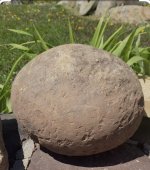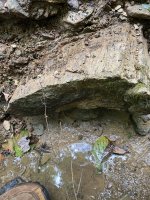bigscoop
Gold Member
- Jun 4, 2010
- 13,373
- 8,689
- Detector(s) used
- Older blue Excal with full mods, Equinox 800.
- Primary Interest:
- All Treasure Hunting
The two remaining ciphers present vastly different and extremely challenging elements that the inexperienced might not recognize so I thought I might take the time to point out these otherwise unrecognized factors.
At first glance one quickly notices an obvious difference in the range of applied codes in each cipher, C1 having 19 four digit codes while C3 appears to be much shorter in range with more frequent use of the same codes. So at first impression it might appear that C3 would be the easier attack but this is a false conclusion and the following is why.
Morriss, Morris
Beale, Beal, Beall
Lions, Lyons, Lyonns
Gene, Jean,
Greg, Gregg,
Timple, Temple,
Obviously, names do not follow the standard rules of correct spelling so there could be endless variations to the spelling of names, and this is only part of the problem. The other part of the problem? Well this revolves around the fact that these names could be of English, French, Dutch, German, Spanish, Mexican, and Italian origin, and so on and so on, all of these nationalities proposing the same variations in the spelling of names and now even in multiple languages. So this is why there is no need for a long range of codes or too much concern that too many codes are being used too often. So when you examine C3 think of it only as an easier looking impossibility without the correct key. Upon examination it might appear to be kinder and gentler and easier to attack but in reality it is presenting an impossible scenario without the correct key to guide you.
“The easier looking impossibility.” Ciphers of this nature are called this because they present a scenario to the decoder that allows him or her to apply any type of spelling to a name that they can make work, this simply being the nature of the vicious beast before them. If Beale will not fit then perhaps Beal or Beall will, this same thing being true of Greg or Gregg, Morriss or Morris, Lions, Lyons, or Lyonns, Gene or Jean, etc., etc., etc. Now, on top of this already impossible scenario, let us toss in the fact that many first names also take place as last names, and vice-verse, such as Ward, Morris, Gregg, etc., etc., etc. So whoever drafted the C3 code sequences had a great understanding of the real challenge presented which is why they didn't fret over a shorter range of codes or the frequent use of the same codes.
So what can we assume from this conundrum? Well, at the very least we can readily assume that the names in the C3 are of varied nationalities and spellings, just as we might expect to encounter in any modern list of 30 names. But obviously, and sadly, this knowledge presents absolutely no measure of advantage at all.
Now for C1, that cipher with the 19 four digit codes and those nasty and mysterious strings, “Forget it!” The only way you're going to crack this cipher is if you have the correct key and detailed instructions for applying it, if in fact the cipher actually contains a true clear text at all? One note worth mentioning, C1 is too long to contain just the secure location of the proposed vault so it is likely that it also contains other information as well if it does contain a true clear text. And as for those 19 four digit codes, well, they could truly represent anything, even entire words or just segments of words, such as; ing, dis, ed, er, etc., etc., etc., as this type of application has been incorporated into ciphers for a long-long time.
And last, at least when playing the lottery we understand the rules and how the game is being played. With these two remaining ciphers we have absolutely no idea of either and absolutely no instruction or guidance. In reality, some lottery games probably offer better odds. Just a little insight I thought I'd pass along.
PS: But in all of this there might also be hint of something strangely and genuinely profound.
At first glance one quickly notices an obvious difference in the range of applied codes in each cipher, C1 having 19 four digit codes while C3 appears to be much shorter in range with more frequent use of the same codes. So at first impression it might appear that C3 would be the easier attack but this is a false conclusion and the following is why.
Morriss, Morris
Beale, Beal, Beall
Lions, Lyons, Lyonns
Gene, Jean,
Greg, Gregg,
Timple, Temple,
Obviously, names do not follow the standard rules of correct spelling so there could be endless variations to the spelling of names, and this is only part of the problem. The other part of the problem? Well this revolves around the fact that these names could be of English, French, Dutch, German, Spanish, Mexican, and Italian origin, and so on and so on, all of these nationalities proposing the same variations in the spelling of names and now even in multiple languages. So this is why there is no need for a long range of codes or too much concern that too many codes are being used too often. So when you examine C3 think of it only as an easier looking impossibility without the correct key. Upon examination it might appear to be kinder and gentler and easier to attack but in reality it is presenting an impossible scenario without the correct key to guide you.
“The easier looking impossibility.” Ciphers of this nature are called this because they present a scenario to the decoder that allows him or her to apply any type of spelling to a name that they can make work, this simply being the nature of the vicious beast before them. If Beale will not fit then perhaps Beal or Beall will, this same thing being true of Greg or Gregg, Morriss or Morris, Lions, Lyons, or Lyonns, Gene or Jean, etc., etc., etc. Now, on top of this already impossible scenario, let us toss in the fact that many first names also take place as last names, and vice-verse, such as Ward, Morris, Gregg, etc., etc., etc. So whoever drafted the C3 code sequences had a great understanding of the real challenge presented which is why they didn't fret over a shorter range of codes or the frequent use of the same codes.
So what can we assume from this conundrum? Well, at the very least we can readily assume that the names in the C3 are of varied nationalities and spellings, just as we might expect to encounter in any modern list of 30 names. But obviously, and sadly, this knowledge presents absolutely no measure of advantage at all.
Now for C1, that cipher with the 19 four digit codes and those nasty and mysterious strings, “Forget it!” The only way you're going to crack this cipher is if you have the correct key and detailed instructions for applying it, if in fact the cipher actually contains a true clear text at all? One note worth mentioning, C1 is too long to contain just the secure location of the proposed vault so it is likely that it also contains other information as well if it does contain a true clear text. And as for those 19 four digit codes, well, they could truly represent anything, even entire words or just segments of words, such as; ing, dis, ed, er, etc., etc., etc., as this type of application has been incorporated into ciphers for a long-long time.
And last, at least when playing the lottery we understand the rules and how the game is being played. With these two remaining ciphers we have absolutely no idea of either and absolutely no instruction or guidance. In reality, some lottery games probably offer better odds. Just a little insight I thought I'd pass along.
PS: But in all of this there might also be hint of something strangely and genuinely profound.
Amazon Forum Fav 👍
Last edited:





